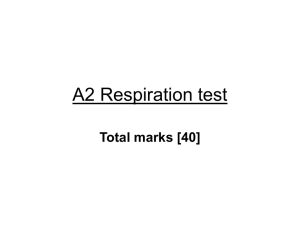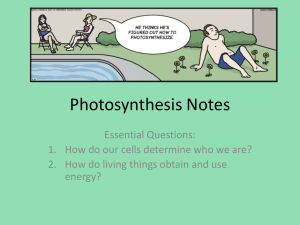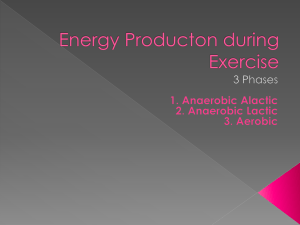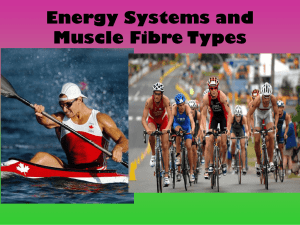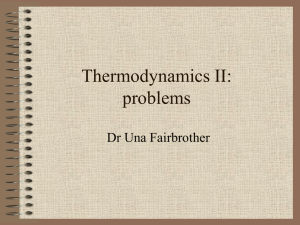P - bellevuebiology
advertisement
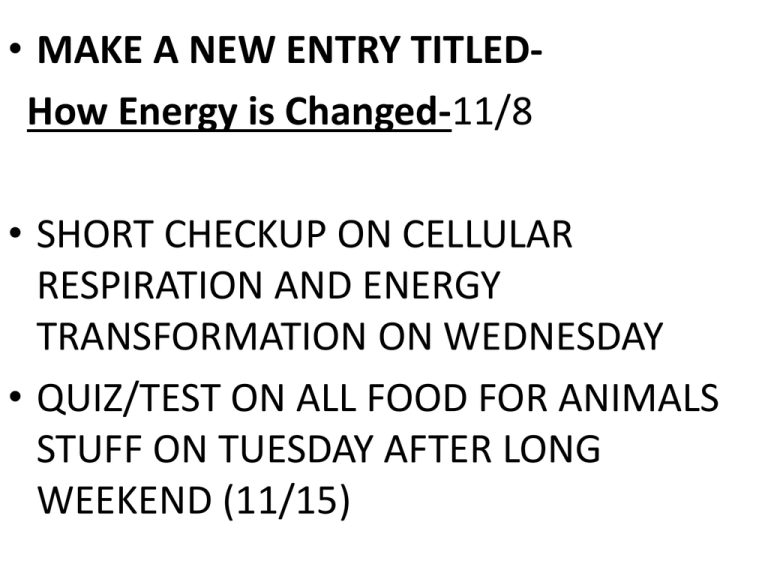
• MAKE A NEW ENTRY TITLEDHow Energy is Changed-11/8 • SHORT CHECKUP ON CELLULAR RESPIRATION AND ENERGY TRANSFORMATION ON WEDNESDAY • QUIZ/TEST ON ALL FOOD FOR ANIMALS STUFF ON TUESDAY AFTER LONG WEEKEND (11/15) •CELLULAR RESPIRATION CLIP •RELEASING CHEMICAL ENERGY CLIP Energy transformations • Marshmallow burned—thermal (heat) energy was released • We said energy was “released” from the marshmallow—but all the molecules/atoms could be accounted for—so where in the marshmallow did the energy come from? • When the bonds of sugar were broken and reformed making CO2 and H2O– energy was released • So…the energy was in the bonds of the molecules • The chemical energy of the sugar molecules was released as thermal energy • So, did the C, H, and O atoms turn into energy when the sugar was burned? • So where is the sugar? • In our body, this process is called CELLULAR RESPIRATION and happens in CELLS MORE stored energy INPUT Glucose OUTPUT CHEMICAL ENERGY LIGHT ENERGY Carbon dioxide LESS stored energy MORE stored energy INPUT Glucose OUTPUT CHEMICAL ENERGY LIGHT ENERGY Carbon dioxide LESS stored energy Carbon cycles between carbon dioxide and glucose as light energy is converted into chemical energy INPUT LIGHT ENERGY OUTPUT CHEMICAL ENERGY • WE HAVE TWO MAJOR IDEAS IN THIS UNIT (HOW WE USE FOOD) 1) GROWTH FROM FOOD—DIGESTION- CIRCULATIONREASSEMBLY, TIME 0-4 ACTIVITY, YOUR TURN HW 2) ENERGY FROM FOOD— part A CELLULAR RESPIRATION-MATTER IS CONSERVED WHEN BONDS OF THE FOOD MOLECULES ARE BROKEN AND ENERGY IS RELEASED part B HOW THE CHEMICAL ENERGY IS CHANGED/TRANSFORMED INTO A TYPE WE CAN USE TO POWER OUR CELLS (KINETIC) • In COMBUSTION (sugar burning), we saw that heat was produced • Our usual body temp—37 C • Room temp is about 25 C • How could you use those two facts as evidence that we produce thermal energy? • What other evidence can you think of that thermal energy is produced in our bodies? • Any similarities between the processes we do and the burning of the marshmallow? • CELLULAR RESPIRATION is very similar to the marshmallow burning—same inputs and outputs Glucose and O2 CO2 + H2O and ENERGY • About 60% of the energy released during CELLULAR RESPIRATION is released as thermal energy. • The other 40% is available to the cell as usable energy for the activities that cells perform. THERMAL ENERGY ATP IN A CELL CHEMICAL ENERGY 40 CHEMICAL ENERGY Building glucose requires energy as an INPUT Glucose Carbon dioxide molecules Breaking glucose releases energy as an OUTPUT 60% will be lost right away as heat/thermal and 40% will be converted to a “useful” form of energy--ATP Kinetic energy Kinetic energy Kinetic energy Kinetic energy Kinetic energy Kinetic energy SO…WHAT IS ATP? ATP IS ACTUALLY OUR ENERGY MOLECULE—NOT FOODEVEN THOUGH WE SAY FOOD IS OUR ENERGY WHY ATP? SODA MACHINE ANALOGY 1 GLUCOSE= 38 ATP’S • In your body, there is actually a step between the chemical energy in glucose being transferred to useful kinetic energy in a muscle cell. Instead, your body first uses the chemical energy in glucose to build a molecule called ATP What is ATP? ATP consists of adenine, ribose, and three phosphate groups. Tri (3) “T” Adenine Adenine Phosphate groups Ribose Ribose ADENOSINE “A” PHOSPHATE “P” ATP and energy used by cells • Cells use energy stored in the form of a molecule called ATP • All other sources of energy must be converted and stored in molecules of ATP to be used by cells P ADENOSINE “A” PHOSPHATE “P” P Adenosine (A) 1 phosphate (P) “mono-phosphate” P Adenosine (A) 1 phosphate (P) “mono-phosphate” P Adenosine (A) 2 phosphates (P) “di-phosphate” P P Adenosine (A) 1 phosphate (P) “mono-phosphate” P P Adenosine (A) 2 phosphates (P) “di-phosphate” P Adenosine (A) 3 phosphates (P) “tri-phosphate” P P AMP P “mono-phosphate” P ADP P “di-phosphate” P P P ATP “tri-phosphate” Note: you do NOT need to memorize names of these molecules The molecular diagrams and names are to help you visualize the processes and help you put the concepts into a context P ATP (Adenosine triphosphate) P P Building ATP requires energy as an INPUT P P P Breaking ATP releases energy as an OUTPUT P P Kinetic energy P ATP has more stored energy (potential energy) than ADP P MORE stored energy P P ATP has more stored energy (potential energy) than ADP P P LESS stored energy P ATP has more stored energy (potential energy) than ADP MORE LESS stored energy stored energy P ATP P P P ADP P P + P MORE stored energy P P P ATP INPUT OUTPUT ENERGY FOR CELLULAR WORK CHEMICAL ENERGY + ADP P P P P LESS stored energy ATP cycles between ADP and ATP as chemical energy is converted into energy for cellular work P P P INPUT OUTPUT CHEMICAL ENERGY ENERGY FOR CELLULAR WORK P P P MORE stored energy INPUT Glucose OUTPUT CHEMICAL ENERGY LIGHT ENERGY Carbon dioxide LESS stored energy MORE stored energy P P P ATP INPUT OUTPUT ENERGY FOR CELLULAR WORK CHEMICAL ENERGY + ADP P P P P LESS stored energy Matter cycles as energy is transformed ATP Glucose P P P Photosynthesis Glucose ATP CHEMICAL ENERGY LIGHT ENERGY ENERGY FOR CELLULAR WORK P P Carbon dioxide CO2 ADP + P P ADP + P Show the transfer of stored chemical energy in glucose to useful/kinetic energy in a muscle cell Glucose ATP IN MUSCLE CELL Chemical Energy Chemical Energy Muscle Cell kinetic Show the transfer of stored chemical energy in glucose all the way into the environment as thermal energy: START WITH GLUCOSE—THEN THE 40%-(TO THERMAL Glucose Chemical Energy ATP in Muscle Cell Chemical Energy Muscle Cell Kinetic Muscle/ Environment Thermal • PUTTING IT ALL TOGETHER: ENERGY IN CELLULAR RESPIRATION 1)How much energy was immediately released to the environment as thermal energy? ______% 60 2)How much energy was transformed into useful 40 energy (ATP)? ______% 3) Where was the energy stored to begin with? In the BONDS of GLUCOSE 4) Where does all the energy ultimately end up? In the ENVIRONMENT as HEAT Thermal Environment Glucose Chemical Energy ATP in Muscle Cell Chemical Energy Muscle Cell Kinetic Muscle/ Environment Thermal





